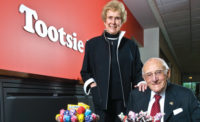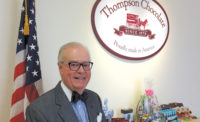
|
Hard to believe that one of the largest confectionery mergers in the United States this year came about from a chance airport meeting. But as Sal Ferrara, chairman and ceo of the newly formed Ferrara Candy Co. (Ferrara Pan Candy Co. and Farley’s & Sathers merged June 18, 2012), told Candy Industry, he just happen to run into Liam Killeen at the Bentonville, Ark. airport.
Killeen, ceo of Farley’s & Sathers, and Ferrara were both booked on a United flight back to Chicago in the summer of 2011. Longtime friends, the two executives started chatting about what they were going to do with the rest of their lives.
But as always is the case between colleagues, the talk turned serious.
“We decided to stop at Meier’s Tavern in Wilmette for a few beers,” Ferrara says. “A few beers later, we were both resolved to go forth with a merger strategy. It really wasn’t rocket science. We knew what both companies brought to the table.”
It didn’t take long for Ferrara to start listing the benefits of the proposed merger: Great brands, with lead items in every season; a strong private label presence, which provides a “full service” relationship with retailers; contract manufacturing accounts, which allows the company “to play” in categories they might not otherwise enter; and ”innovation, distribution and manufacturing expertise unparalleled in the United States.”
All of these factors supported the idea of merging the two companies together.
Ferrara, who was instrumental in helping grow Ferrara Pan Candy Co. from $3 million to $350 million during his tenure as ceo, recognized that future growth as a midsized manufacturer involved overcoming increased consolidation in the industry.
“In looking at the future, the reality is that there’s consolidation in every aspect of our lives,” he says. “There are only four sugar suppliers; the number of corn syrup suppliers is shrinking; the aggregate of corrugated suppliers are being bought by nationals.”
Within the retail landscape, consolidation is even more prevalent, Ferrara emphasized. Be it mass merchandisers, drug store chains, club stores, discount chains, the key players for each segment can be counted on one hand.
Even within the supermarket and grocery segment, parent companies dominate, supplemented by large regional players.
“We had to become a bigger, more important player,” he says. “It’s all about the cost of going to market. You can’t be a regional player anymore; you have to ship all over the country. If you only have one or two items, the cost of doing business is that much greater.”
The subsequent merger of Ferrara Pan Candy Co. (sales estimated at $350) and Farley’s & Sather’s (sales estimated at $650) created a billion-dollar, full-line confectionery company.
“That’s a good-sized company for our category,” Ferrara acknowledges. Moreover, it’s significantly well-balanced, with revenue streams coming mostly from brands, but also contract manufacturing, bulk sales and private label, he adds.
“We have the lead items in the non-chocolate set for every season,” Ferrara says. “We supply 92% of the mallowcreme segment; we’re the largest producer of candy canes; we sell more conversation hearts than anyone else; and we make almost all the jelly beans than are consumed in the United States. We’ll be able to leverage our seasonal items with everyday products. The industry needs a non-chocolate, full-service supplier like us.”
Ferrara also points to another trend that will affect the U.S. confectionery landscape: private label. Current estimates peg private label confections as accounting for 3% of all candies sold. Ferrara says the sector is growing and will continue to do so.
“Private label will grow to 4% by the end of the year,” he says. “You look at the West European model and the United States is nowhere near the amount of private label confections sold there. But consider the success of Aldi here. Then there’s the expansion of Wal-Mart’s Great Value brand and continued product extensions behind Walgreen’s Delish &Nice brands.”
“We want to be the player,” he continues. “We want to be the biggest, best, most reliable supplier through all categories.”
The company has the means to meet that goal, Ferrara says.
“We have 21 starch moguls; the rest of the United States has 19,” he says. “We have between 700 to 800 pans. No one out there has more than 150.”
But it’s not just about production capacity or manufacturing/packaging equipment, although all that plays a role.
“It’s about bringing together the best of the best,” he says. “Liam [Killeen] is one of the best candy marketers in the global industry. He’ll head up our marketing efforts as chief marketing officer and he’ll be president of the international group. Tom Polke, who’s been my right-hand man for almost 10 years, will be president of the company. Linda Severin, most recently v.p. - store brands for Kroger, joined us in June and will be our vice president of marketing.”
Integrating two companies never happens without some challenges, admits Ferrara since the corporate cultures are different.
“Farley & Sather’s had what I’d call a normal culture; Ferrara Pan’s was somewhat unique,” he says. To better meld the two, the company will move into new corporate offices in Oakbrook Terrace, a western suburb of Chicago.
“I’m too old to change my ways,” he says.” The way I like to do things is to resolve problems immediately, take advantage of opportunities immediately. So if there’s a problem or an opportunity, we’re all within shouting distance.”
Plans call for Ferrara Candy Co. to occupy two floors of Oak Brook Terrace Towers. In addition to housing executive, sales, marketing and customer service departments, the new offices will also be home to IT, procurement, finance, SAP, and HR. In total, 145 people will man the corporate offices.
“We want to be quick to market, have a fast response time,” Ferrara adds. “I want to make sure that we have fire in our bellies as we grow and become better, focused on being an important player in the eyes of our customer.”
To do so will involve making some changes to the company’s 11 manufacturing plants. The company will shift production to take advantage of efficiencies within the manufacturing network.
“We’ll have primary plants focusing on product categories, then secondary locations that can handle overflow and/or meet capacity issues,” he says.
For example, the Bellwood, Ill. facility will now become a starch mogul manufacturing facility, Ferrara says. The company’s breakable chocolate ball line will be moved to the Jersey Pike plant in Chattanooga, where most of the company’s chocolate production takes place.
The research & development lab in Chattanooga will remain intact while the research & development facilities in Forest Park, Ill. will be enlarged. Transition of Ferrara’s SAP system into total control of the Farley/Sather’s operation is already under the way, with an Oct. 1 deadline in place for total integration.
Total investments by Ferrara Candy Co. will reach “tens and tens of millions,” Ferrara says. All these moves (excluding the SAP integration) and more — are scheduled for completion by Jan. 1. The driving force behind the improvements — customers.
“It’s about understanding their needs, not just selling a brand,” he says.
It’s a skill that served Ferrara well as he worked patiently to secure approval for the deal at Ferrara Pan Candy Co. While all shareholders within the company came from the three families, the Paganos, the Buffardis, and Ferraras, the demographics of each ranged from teenagers to senior citizens.
“It was an unusual deal,” he explains. “The objectives and needs and desires of various [Ferrara Pan Candy Co.] shareholders differed.”
To balance out varying needs and wants, the shareholder’s proposal offered options, everything from cash buyouts to shares in the new company.
“There were a lot of entities involved, and several options, so it took longer for some shareholders to decide what they wanted,” Ferrara explains. “But everybody’s happy, the options satisfied the needs of all players.”
The deal also satisfied someone very close to Ferrara, his father, Nello.
“I had kept my father abreast of the negotiations from the very beginning,” he says. “So he would ask me about what was going on. ‘What is it going to be called,’ he asked me. I said ‘Ferrara Candy Co.’ He smiled. ‘Who’s going to run it?’ ‘I’m the chairman and ceo.’ He was pleased. But he kept asking how much longer before the deal would be done. “
In January 2012, Nello Ferrara became sick. He passed away Feb. 3.
“I left his home for work one morning and shortly after arriving at the office I got a call to quickly go back to his house; they told me he was going fast,” Ferrara recalls. “I walked into the room and he motioned to me to come closer. I sat on the edge of his bed and he could barely talk. But he asked me, ‘ Deal? Deal?’ I told him it was done, all finished. He said, ‘Happy, happy.’ Those were his last words. Within 10 minutes he passed away. It was important to him. He was quite a man.”
Although the merger wasn’t officially consummated until June 18 – lawyers on both sides took time dotting the I’s and crossing the t’s Ferrara explains – the shareholder agreements were already in place.
His father’s final moments dramatically reaffirmed Ferrara’s vision for the company.
“I see a lot of growth coming for the company,” Ferrara says. He projects double-digit growth, but is cognizant of the fact that 10% of a billion dollars is a much larger figure than 10% of $350 million. Regardless, he’s up for the challenge.
“I’m not afraid of work. Plus, there are many ways to grow a company,” he explains. “You can do it through new product development and innovation, through increased distribution, through increased turns, through acquisitions. We’ll be looking to grow through all means available to us.”
Nello would be proud.





